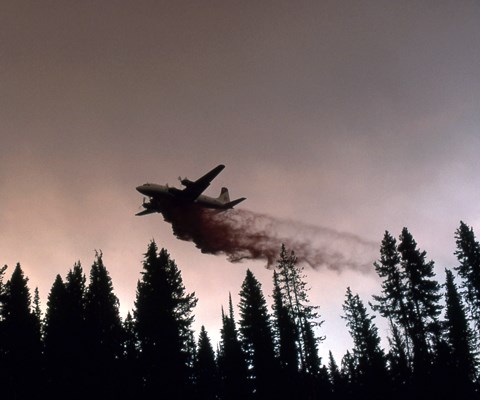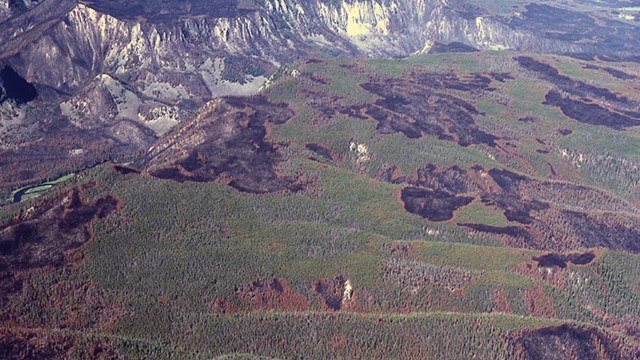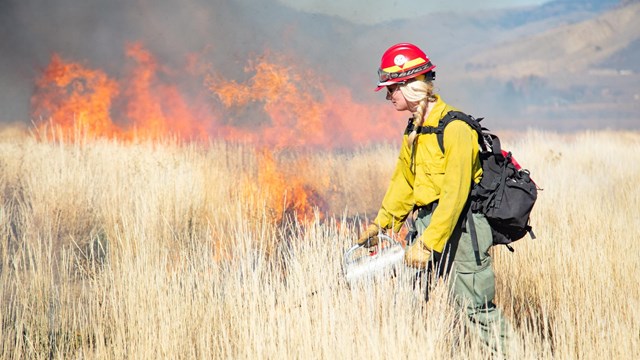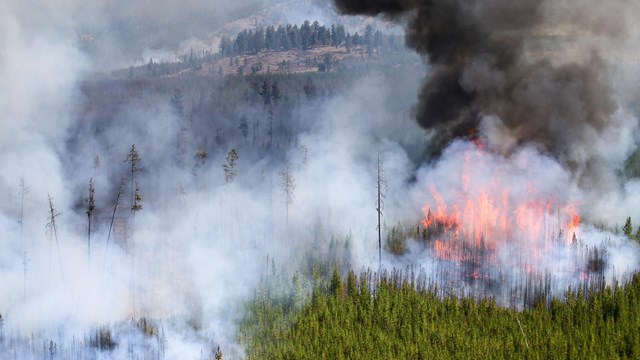
NPS The Yellowstone fires of 1988 have been described as being instrumental in the public’s understanding of the role of fire in ecosystems. In June of 1988, park managers and fire behavior specialists allowed 18 lightning-caused fires to burn after evaluating them, according to the fire management plan. Eleven of these fires burned themselves out, behaving as many fires had in previous years. The spring of 1988 was wet until June, after which hardly any rain fell. Park managers and fire behavior specialists expected that July would be wet, as it had been historically. Rains did not come in July as expected. Because of the extremely dry conditions, no new natural fires were allowed to burn after July 15 except those started adjacent to existing fires that were clearly going to burn into existing fires. Even so, within a week the fire acreage in the park doubled to about 17,000 acres. After July 21, all fires—including those started naturally—were fully suppressed as staffing would allow. (Human-caused fires had been suppressed from the beginning.) 
NPS Fighting the FiresAn extensive interagency fire suppression effort was initiated in mid-July in the Greater Yellowstone Ecosystem in an attempt to control or contain this unprecedented series of wildfires. The extreme weather conditions and heavy, dry fuel accumulations presented even the most skilled professional firefighters with conditions rarely observed. Fire fighting efforts were directed at controlling the flanks of fires and protecting lives and property in their paths. The fire experts on site generally agreed that only rain or snow could stop the fires. They were right: one-quarter inch of snow on September 11 stopped the advance of the fires. Frequently Asked QuestionsThe 1988 fires affected approximately 800,000 acres (or ~36%) of the park. Five fires burned into the park that year from adjacent public lands, including the largest, the North Fork Fire. It started accidentally and burned more than 410,000 acres.
Yellowstone usually experiences afternoon showers three or four days each week during the summer, but in 1988 no measurable rain fell for almost three months. The most severe drought in the park’s recorded history occurred that summer. Also, a large number of lightning strikes came with a series of dry storm fronts. This lightning started many of the fires and storm fronts stoked them with particularly high and sustained winds.
It is possible the few fires that started in early June might have been extinguished. However, between 1972 and 1987, the average fire had gone out naturally after burning only one acre. So, while the early fires were monitored closely and some were contained from going out of the park, the history of fire behavior in Yellowstone, coupled with an abnormally wet spring, suggested these fires would go out as previous fires had. After July 15, all fires were fought aggressively from the moment they were detected. Despite the largest fire fighting effort at that time in the history of the nation, weather finally contained the fires when snow fell in September.
After the fires of 1988, a national policy review team examined the national fire policy again, and concluded that natural fire policies in national parks and wilderness areas were basically sound. It also recommended improvements that were incorporated into the National Park Service’s fire policy of June 1990 and into Yellowstone National Park’s fire management plan of 1992.

NPS Post-fire Response and Ecological ConsequencesBy late September, as the fires were diminishing, plans were already underway in Yellowstone to develop comprehensive programs for all aspects of post-fire response. Scientists wanted to monitor the ecological processes following these major fires. The National Park Service cooperated with other agencies and independent researchers and institutions in developing comprehensive research directions for this unparalleled scientific opportunity. Observations actually began while the fires were still burning. Burning at a variety of intensities, the fires killed many lodgepole pines and other trees but did not kill most other plants; they merely burned the tops, leaving roots to regenerate. Temperatures high enough to kill deep roots occurred in less than 0.1% of the park. Only under logs and in deep litter accumulations, where the fire was able to burn for several hours, did lethal heat penetrate more deeply into the soil. Where water was available, new plant growth began within a few days. In dry soils, the rhizomes, bulbs, seeds, and other reproductive tissues had to wait until soil moisture was replenished the following spring. Though animal movements were sometimes affected dramatically by the passage of fires, relatively few animals died. However, portions of the northern range burned, which affected winter survival of grazing animals when coupled with summer drought conditions. In this and many other ways, fires dramatically altered the habitat and food production of Yellowstone for the short term. The fires of 1988 created a landscape of burns, partial burns, and unburned areas—called a mosaic. A mosaic provides natural firebreaks and sustains a greater variety of plant and animal species. Vegetation capable of sustaining another major fire will be rare for decades, except in extraordinary situations. Photo Point Along Road Between Canyon and Norris Junctions 

Left image
Right image

Ecological Consequences of Fire
Fire plays a vital role in a functioning ecosystem, and many plants have adapted to - or become dependent on - fire. 
Fire Management
Learn how the park balances the benefits and threats of fire on the landscape. 
Fire Ecology
Learn about fire's role in Yellowstone. |
Last updated: April 22, 2025
